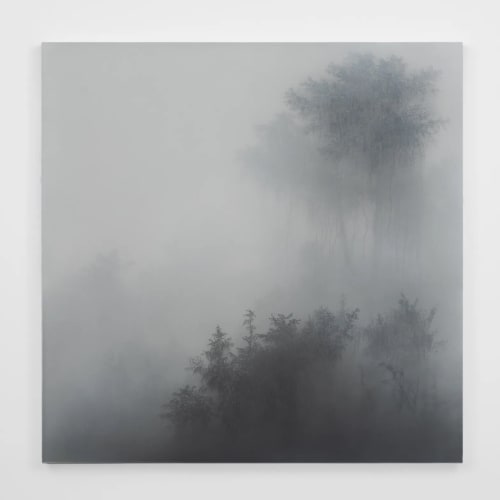In August of 2022, I spent an afternoon in Kibong Rhee’s studio in Gwangju, South Korea, about an hour north of Seoul. Ever since that day, I have been thinking about how Rhee’s spatially indeterminate paintings of watery, mist-enshrouded landscapes open up a conceptual framework that I had yet to wrap my head around. One way to understand Rhee’s art is to see how it connects to the writings of philosopher Ludwig Wittgenstein, and the question of how we know what we know. Wittgenstein was a touchstone during my conversation with the artist, and a number of his paintings contain quotes by the philosopher in English and Korean. When I left the studio, I knew that I had to see Rhee’s work again because I was sure that I was missing something. Even though I had spent a long time looking at the pieces, they were conceptually complete in ways I was not quite grasping.
There is no place at Tina Kim Gallery is the artist’s first exhibition at this gallery, and his first in the United States since 2011. Along with 10 paintings, the show includes an installation, “Mistygraphy–Cut Section” (2024), composed of two abutted horizontal sheets of glass supported by a steel structure. Behind the glass, which is a considerable distance from the wall, Rhee has applied black latex to the walls, its size and shape echoing the glass, and spanning nearly the entire wall of one of the two gallery spaces. The glass is transparent enough to see through, while at the same revealing ethereal reflections of the viewer and the entire room. The partially reflected images complicate perception, resulting in a disorienting effect. What does it mean to see through a semi-transparent plane to a black wall or dead end, while catching a glimpse of yourself looking?
When I asked Rhee about “Mistygraphy–Cut Section,” he answered gnomically that one’s eyes are either closed or open, asleep or awake. When he closes his eyes, he sees only darkness, which he associates with the darkness of an expanding, limitless universe. When he opens his eyes, he sees reality, in which he is partially reflected.
Like the installation, the paintings consist of two layers with a space between them. The surface layer is a porous polyester fiber; beneath it is a piece of canvas that fits exactly within a shallow box. Using a limited palette of different grays, Rhee paints on the canvas and polyester fiber. I see this combination as alluding to both Western oil painting and Asian ink painting; the latter is done on paper and occasionally silk and cannot be scraped down or altered. In Rhee’s work, each medium influences how the other is seen. Together, they make a hybrid object that goes beyond their individual elements.
Rhee’s misty landscapes are based on both memory and imagination. They pull us into a world that does not exist, which helps explain the exhibition’s title, There is no place. Although they are hyperreal, the view changes radically as we get closer to the surface. From a distance, the painting looks almost like a photograph, but the image is spatially dimensional rather than flat. It is as if we could be swallowed up by the mist. Neither conventional painting nor photography can achieve this effect, which makes a fresh visual experience. Like filmic images of a foggy three-dimensional world in which, paradoxically, time passes and nothing changes, the tension seems more than just formal.
The delicate abstract lines, marks, and drips of Rhee’s paintings are enhanced by his attention to shifts in tone and hue. Visually, they define an impossible space that is simultaneously photographic and painterly. All of this changes when we get close to the surface and recognize that the field of abstract liquid lines and drips do not seem connected to the pictorial images that we see from afar, and the space between the layers offers no clue as to how Rhee achieves his optical effects. This fissure between seeing and knowing is what links him to Wittgenstein, as both are interested in the slippery relationship between perception and articulation.
I think the gap between different states of consciousness is Rhee’s primary subject. He creates these apertures by making a two-layer painting, which changes from a pictorial presentation of a lush, dreamy world to a tangled web of different viscosities when we approach its surface. I cannot think of another artist who has been able to achieve such a radical division in their work. Surprisingly, he uses a wide housepainter’s brush to get a network of delicate lines.
“Differences – The Imprinted” (2024) is a barely legible black square painting whose geometric format brings to this viewer’s mind the work of Ad Reinhardt. This is the most elusive painting in an exhibition of tantalizing views. I kept alternating between looking at the painting as a whole and trying in vain to see through the porous surface to discern the imagery on the canvas layer. After doing this a number of times, I saw different clusters of words along the top of the painting. Reading them proved impossible, which did not bother me.
When I began thinking about Rhee’s painting, I thought of Georges Seurat and his pointillist dots. We can move smoothly from the dot to an optical image. In Rhee’s “Mistygraphy” (2023), a disruption opens up, conveying the gap between seeing and naming. This is the gap that Wittgenstein pondered throughout his life without reaching a satisfying conclusion. Like Wittgenstein, Rhee’s paintings are powerful evocations of the mind-body split, and how language is unable to grasp the elusiveness of the senses. His innovative, challenging work should be internationally known.
—John Yau


